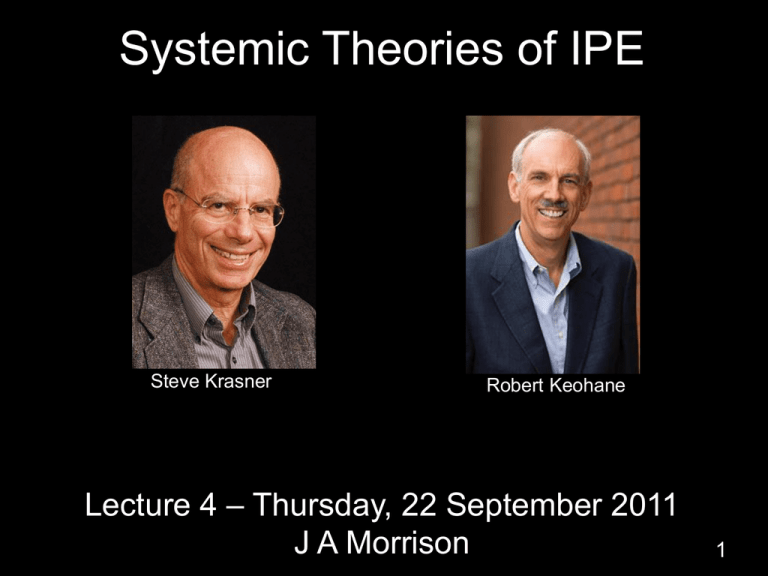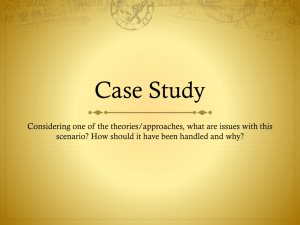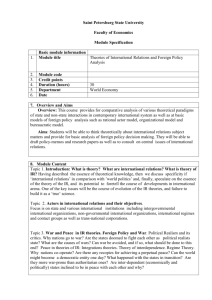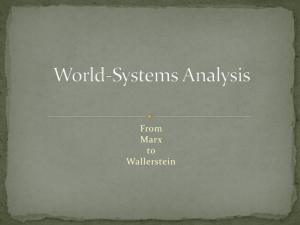Slides - James Ashley Morrison
advertisement

Systemic Theories of IPE Steve Krasner Robert Keohane Lecture 4 – Thursday, 22 September 2011 J A Morrison 1 Lec 4: Systemic Theories of IPE I. The Big IPE Puzzle: Globalization II. Systemic Theories III.Interstate Competition IV.Hegemonic Stability Theory V. Institutions “After Hegemony” VI.Conclusion 3 Lec 4: Systemic Theories of IPE I. The Big IPE Puzzle: Globalization II. Systemic Theories III.Interstate Competition IV.Hegemonic Stability Theory V. Institutions “After Hegemony” VI.Conclusion 4 What is globalization? 5 Let’s say globalization is the minimization of the influence of space on social, political, and economic outcomes. 6 Clearly, technology is lowering the cost of moving people, products, and capital across space. So, is globalization inevitable? 7 What do Grieco & Ikenberry (Ch 1) say about the inevitability of globalization? 8 In IPE, we might assess the level of globalization by measuring the level of trade, cross-border capital flows, and/or international migration. 9 Measures of Globalization • Trade: Share of Exports in World Output – Peaked in 1913 – This point was not surpassed until 1970 (G&I, 5) • Capital: Flows relative to National Income – Level of integration still has not reached the levels achieved among developed countries between 1870 and 1913 (G&I, 217) • Migration: Movement relative to World Population – More people crossing borders in 1900 than today (Hatton & Williamson, 1998; Ratha & Xu, 2008.) 10 By some measures, the world was more fully globalized in 1900 than it is today. 11 Damn. 12 Imagine the implications for production costs, product selection, social stability, and even international relations. 13 This raises a vital question: If globalization isn’t inevitable or irreversible, then what explains variation in the last century of globalization? 14 Politics. States’ foreign economic policies mitigated against (minimized) economic integration. 15 Economic models don’t tell us what happens on the ground. For a variety of reasons—some “good” and some “bad”— policymakers often don’t heed the prescriptions of economists. 16 “Neoclassical theory recognizes that trade regulations can . . . be used to correct domestic distortions and to promote infant industries, but these are exceptions or temporary departures from policy conclusions that lead logically to the support of free trade…Historical experience suggests that policy makers are dense, or that the assumptions of the conventional argument are wrong. Free trade has hardly been the norm. Stupidity is not a very interesting analytic category.” (Krasner, 2021) 17 “[I]n the absence of cooperation, governments will interfere in markets unilaterally in pursuit of what they regard as their own interests, whatever liberal economists may say.” (Keohane, 50) 18 Here’s the point... We can’t understand the development of the global economy without understanding foreign economic policy. That means understanding politics. 19 Lec 4: Systemic Theories of IPE I. The Big IPE Puzzle: Globalization II. Systemic Theories • Interstate Competition • Hegemonic Stability Theory • Institutions “After Hegemony” • Conclusion 20 Trying to understand the retreat of globalization between 1914 and 1945 is one of the biggest questions in IPE. So-called “structural” and “systemic” theories were among the first attempts to resolve this puzzle. 21 What are structural/systemic theories? 22 Structural/systemic theories emphasize the role of structure of the international system in shaping outcomes of interest. 23 Focus is on Waltz’s 3rd Image: the level of the international system. This structure is independent of the ideas, institutions, and interests that exist within states. (We’ll look within states next time.) 24 What defines the structure of the international system? 25 Key Structural Elements of International System • Anarchy: the absence of overarching political power • The existence of exit-options for market actors • The distribution of power among states (see Krasner, 20) • The scope and influence of international regimes 26 Lec 4: Systemic Theories of IPE I. Some Key Terms II. Systemic Theories III.Interstate Competition • Hegemonic Stability Theory • Institutions “After Hegemony” • Conclusion 27 G&I retell the story (from Doug North and others) about the role of interstate competition in shaping political and economic development. (See p 107.) 28 What’s that story? 29 Lec 4: Systemic Theories of IPE I. Some Key Terms II. Systemic Theories III.Interstate Competition IV.Hegemonic Stability Theory • Institutions “After Hegemony” • Conclusion 30 IV. HEGEMONIC STABILITY THEORY 1. 2. 3. 4. Overview The elegance of HST Krasner’s theory Testing Krasner 31 Hegemonic Stability Theory (HST) is a systemic theory of international politics (IP): “the openness and stability of the world economy depends on the presence of a hegemonic power that, acting in its own enlightened self-interest, plays the role of organizer and supervisor of the world economy.” (G&I 111) Distribution of Power (IV) Patterns of Interstate Relations (DV) 32 Major Variants of HST • Kindleberger (1973): Willing hegemon is needed to support international monetary system • Krasner (1976): Hegemony brings economic openness (read: free trade) – “State Power and the Structure of International Trade.” (1976) -- (There are lots more theorists in this tradition!) 33 We’ll focus on Krasner today and Kindleberger when we study money in several weeks. 34 IV. HEGEMONIC STABILITY THEORY 1. 2. – – Overview The elegance of HST Krasner’s theory Testing Krasner 35 HST is elegant. It resolves Thomas Hobbes’ old question… 36 We know that economic integration generally does not follow without some cooperation. Why not? 37 A state might use asymmetric costs of closure as leverage against other states (e.g. After opening Canada’s markets, the US could threaten to close the borders if Canada does not support the US in Iraq.) 38 But states exist in anarchy, in a “self-help” system. As Hobbes asked, how do we get cooperation without a state authority to enforce agreements? 39 HST provides a potential answer: hegemons serve as a proxy for state authority to reduce the “anarchy.” Hegemons can use both sticks and carrots to open foreign markets. 40 IV. HEGEMONIC STABILITY THEORY 1. 2. 3. – Overview The elegance of HST Krasner’s theory Testing Krasner 41 Be sure to “Get” Krasner • Exemplary of Systemic Approach • Classic, widely cited article with • extraordinary influence Lucid—if not problematic—analysis of IPE (see Keohane, 1997) • Notice the explicit discussion of his research design: defines his variables clearly, highlights his operationalization, and discusses all of his findings 42 Puzzle: Openness vs Social Stability • Policymakers have cross-cutting preferences: power, wealth (income & growth), social stability, • Openness brings wealth, choice, and interdependence • BUT openness also undermines social stability: inequality, shocks, transition costs (job loss) 43 Given these cross-cutting preferences, how do policymakers choose the degree of openness they’ll allow? 44 Different Systems --> Different Levels of Openness • Small, Developed Economies Openness • Large, Unequally Developed Closure • Hegemonic System Openness – In interest of hegemon – Small states have little choice; mine as well get benefits of openness 45 Krasner: Hegemony Trade “The most important conclusion of this theoretical analysis is that a hegemonic distribution of potential economic power is likely to result in an open trading structure.” 20 46 IV. HEGEMONIC STABILITY THEORY 1. 2. 3. 4. Overview The elegance of HST Krasner’s theory Testing Krasner 47 Now, let’s operationalize and test the argument. 48 The DV: “Economic Openness” “The degree of openness can be described both by the flow of goods and by the policies that are followed by states with respect to trade barriers and international payments.” 24 49 The IV: Distribution of Potential Economic Power Narrower version of “potential power,” “such factors as gross national product, per capita income, geographical position, and size of armed forces.” 28 50 Testing the Argument ✓ Moves toward Closure! ✓ Increasing Closure Increasing Closure ≈ Sharp closure; American ! resistance Increasing openness ✓ Increasing openness ! Time Period IV: Distribution of Power DV: Level of Openness 1820-1880 British Ascendance Increasing Openness 1880-1900 British Maintain 1900-1914 Early British Decline 1914-1930 British decline; Very early American rise 1930-1945 British down; Americans rise 1945-1960 Americans ascendant 1960-Present (1976) American decline 51 How does Krasner amend the argument? 52 Lag the dependent variable: institutional trends are sticky; sometimes it takes a while and/or an exogenous jolt. 53 Lec 4: Systemic Theories of IPE I. Some Key Terms II. Systemic Theories III.Interstate Competition IV.Hegemonic Stability Theory V. Institutions “After Hegemony” • Conclusion 54 Led by Robert Keohane, a group of scholars (sometimes called neoliberal institutionalists) questioned whether it was possible to have openness after hegemony. (Note the title of Keohane’s book!) 55 This followed largely from the recognition that openness has persisted (and expanded!) even as American relative economic power has declined. 56 What explains this persistence? International Regimes. 57 International regimes: "sets of implicit or explicit principles, norms, rules and decision-making procedures around which actors' expectations converge in a given area of international relations. Principles are beliefs of fact, causation, and rectitude. Norms are standards of behavior defined in terms of rights and obligations. Rules are specific prescriptions or proscriptions for action. Decision-making procedures are prevailing practices for making and implementing collective choice” (Keohane, 57) 58 What Regimes Do • Define obligations convergence of expectations • Provide information monitoring & compliance • Reduce transaction costs more likely to cooperate again • Ensure “repeated play” increase importance of reputation • Enforcement through denial of “carrots” (and sometimes use of “sticks”) 59 Lec 4: Systemic Theories of IPE I. Some Key Terms II. Systemic Theories III.Interstate Competition IV.Hegemonic Stability Theory V. Institutions “After Hegemony” VI.Conclusion 60 So, IPE scholars are particularly interested in the variation in the level of economic integration observed over the last several centuries. That is one of the biggest DVs of interest. 61 Systemic theories suggest that the structure of the international system is the key IV that shapes states’ foreign economic policies—which determine whether globalization occurs. 62 Hegemonic stability theorists (Krasner & Kindleberger) think that the concentration of power in the hands of one state is enough to overcome states’ reluctance to open markets. 63 Scholars like Robert Keohane (“neoliberal institutionalists”) argue that it is possible to achieve cooperation without hegemony by using international regimes. 64 But does the structure of the international system really explain all of states’ foreign economic policies? What about domestic politics: the institutions, interests, and ideas within states? 65 That’s where we’re headed next time! I can’t wait! 66






